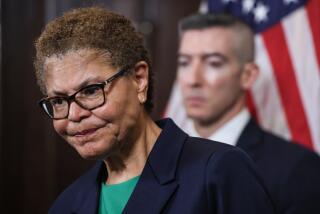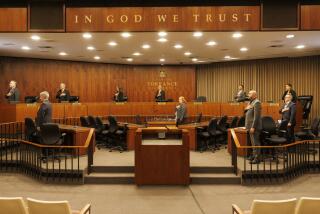City Manager to Explain Crunch to Public Tonight : Torrance Braces for at Least Two Lean Years
- Share via
If these are not the worst of times for the Torrance city government, neither are they the best--financially speaking.
- Sales tax revenues have fallen below projections by $433,000--about 3.9%--as of Dec. 31, the six-month mark in the current fiscal year.
- This is the last fiscal year for federal revenue sharing, which has pumped in about $1.6 million a year for more than a decade. Other federal funding is chancy because of deficit-reduction efforts.
- The recently passed state Proposition 62 limiting local taxes may further restrict the city’s options.
- Torrance, which has $53.5 million in bonds outstanding, cannot afford to take on additional debt. Bond payments--$1.8 million this fiscal year--will rise to $3.2 million the next.
Those are the constraints outlined in a memorandum sent to council members last week by City Manager LeRoy Jackson. He will conduct a public discussion on budget matters at 7 tonight in the Library Meeting Room in the Civic Center.
In addition, said Mayor Katy Geissert, several major unexpected expenses have hit the city recently.
Both officials said the city’s long-term financial prospects are good, though the next few years will be comparatively lean.
To cope with the crunch, Jackson, who in an interview described the city’s overall finances as “sound,” is proposing a two-pronged approach--a pause of at least two years in the city’s “aggressive” building program and, for better planning, two-year budgets instead of the current one-year spending plans.
Recent city construction projects include the $1.7-million Fire Station 6, completed in January; the $11.3-million city equipment yard, which is almost completed, and the $10-million Cultural Arts Center, which is being designed.
Proposed projects include Fire Station 7, a new training facility for firefighters and a park project.
Although it is too early in the year for final decisions on the 1987-88 budget, Jackson is already warning the council and residents that hard decisions lie ahead.
“We have less revenue than we expected,” he said. “The budget for next year looks not overwhelmingly advantageous. It just may not allow for significant enhancement.”
Geissert agreed. “It is certainly a year when we are not going to be looking at new programs,” she said in an interview.
In addition to the factors cited by Jackson, Geissert said the city has been hit with unexpected costs--more than $2 million connected with a hillside slide, $2 million to acquire Greenwood Middle School when the school board decided to sell it and a $250,000 settlement against the city, which is self-insured, for a fatal accident on Western Avenue.
“Those are things that drained our reserves. They are very hard to swallow even in an $80-million budget,” she said.
Jackson, however, cautioned against overstating the problem. He said that despite the shortfall, sales tax receipts are “still coming in strong, surprisingly strong,” considering that the city had based its revenue projections on a higher inflation rate. He emphasized that the city faces no cutbacks--just a deferral of future spending plans.
The long-term outlook--once sales and property tax revenues generated by redevelopment “start rolling in”--is bright, Geissert said. “I see this as a short-term tight budget.”
Jackson’s proposed two-year budget system received qualified support from Geissert, who called it “a wise thing to do.”
The proposal comes after Jackson received a critical performance evaluation last summer by council members, who urged him to concentrate on long-range planning to strengthen the city’s financial position.
“It is always wise to have a road map before you start out,” Geissert said. “Perhaps for two years you can make somewhat reliable projections.” She said the second year’s budget should be considered primarily a planning document subject to change.
More to Read
Sign up for Essential California
The most important California stories and recommendations in your inbox every morning.
You may occasionally receive promotional content from the Los Angeles Times.










